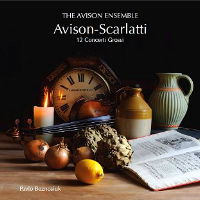
Bold and Inventive
Charles Avison's
reworkings of Scarlatti -
enjoyed by
ROBERT ANDERSON'Avison's deployment of massed strings is wonderfully effective ...'
|

|
Charles Avison (1709-70) began life in Newcastle, visited London for study with Geminiani, and returned north for the rest of his days, mostly as organist of St Nicholas, Newcastle, the present cathedral. A main distinction was authorship in 1752 of his Essay on Musical Expression, a pioneer work of music criticism in England. He was resurrected a hundred years on by Robert Browning, for whom he became so fascinating a subject as to be included in a work of the poet's latter years, Parleyings with Certain People of Importance in their Day. Avison showed that music in his day was quite as central to human experience and debate as Wagner's was then.
It is unlikely Browning had heard these Avison reworkings of Scarlatti. It is hardly surprising, though, that the northern composer was entranced by what he came to know from Thomas Roseingrave's 1739 publication of some forty-two of Domenico's Essercizi. Describing him as 'bold and inventive', among the great masters of the period, Avison embarked on a manuscript quest of his own. The result was material enough to piece together twelve concerti grossi from Scarlatti harpsichord pieces. Or was it ? Avison favoured the four-movement, or 'da chiesa' concerto form, in which each work required two slow movements.
Scarlatti's harpsichord writing is essentially brilliant and extravert. The majority of the movements can be readily identified with Kirkpatrick's numbering of the sonatas, though there has been transposition here and there, or such alteration as topping and tailing. But of the twenty-four slow movements, as many as ten are of unknown origin. This suggests that Avison may have had recourse to other composers for this music, or indeed to his own more than adequate inventive powers. It is highly significant that seven such movements occur in the last four concertos, as if Avison had finally run out of Scarlatti material that could be of use.
A main joy of Scarlatti is to observe how far Iberian music, with its sudden mood changes from major to minor and back, had worked its way into his consciousness. It clearly pleased Avison equally, as is evident from the first Allegro in Concerto No 1.
Listen -- Avison/Scarlatti: Allegro Kk24 (Concerto No 1)
(CD 1 track 2, 0:00-1:08) © 2008 Divine Art Ltd
There are similar hints of local colour in the brilliant passagework that depends on the virtuoso direction of Pavlo Beznosiuk during the Con furia of No 6.
Listen -- Avison/Scarlatti: Con furia Kk29 (Concerto No 6)
(CD 1 track 22, 0:00-1:14) © 2008 Divine Art Ltd
Simon Fleming's liner notes remind us of Laurence Sterne's linking this 'mad' movement with the nature of Tristram Shandy's birth.
Avison's deployment of massed strings is wonderfully effective in the sombre opening to Concerto No 3.
Listen -- Avison/Scarlatti: Largo andante Kk89c (Concerto No 3)
(CD 1 track 9, 1:12-1:40) © 2008 Divine Art Ltd
The result is a Handelian splendour, though Handel did not rate as highly as one might expect in Avison's musical pantheon. At an opposite extreme is the subtle deployment of sinuous fugal lines in the third movement of Concerto No 5. One of the mystery movements -- provenance unknown -- is the Largo that begins Concerto No 9.
Listen -- Avison: Largo (Concerto No 9)
(CD 2 track 9, 0:00-0:30) © 2008 Divine Art Ltd
Again there immediately springs to mind the name of Handel, music's most notorious borrower of other people's tunes.
Avison could make no use of the close-knit crashing harmonies that are so individual a feature of Scarlatti's left-hand writing. These were probably among the capricious diversions Avison was wary of in his admired composer. But he relishes Scarlatti's playfulness and throw-away chromatics in such a movement as the Allegro of Concerto No 4.
Listen -- Avison/Scarlatti: Allegro Kk3 (Concerto No 4)
(CD 1 track 14, 0:00-0:28) © 2008 Divine Art Ltd
The first Allegro of Concerto No 12 is almost as 'mad' in its headlong course as the Tristram Shandy movement.
Listen -- Avison/Scarlatti: Allegro spiritoso Kk23 (Concerto No 12)
(CD 2 track 22, 0:48-1:36) © 2008 Divine Art Ltd
The Ensemble has long passed a half-century of Avison concerto recordings. This admirable CD is, one hopes, harbinger of many more happy discoveries at the back of northern cupboards.
Copyright © 21 December 2008
Robert Anderson, Cairo, Egypt
 BUY CLASSICAL CDS ONLINE
CD INFORMATION: AVISON-SCARLATTI - 12 CONCERTI GROSSI
BUY CLASSICAL CDS ONLINE
CD INFORMATION: AVISON-SCARLATTI - 12 CONCERTI GROSSI
| 
